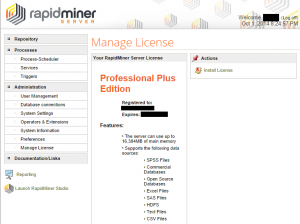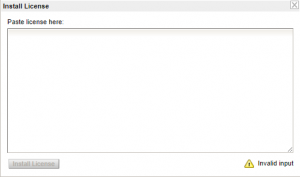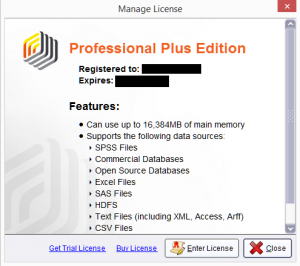This week I’ve been putting RapidMiner Server through its paces to prove capability for a potential customer. RapidMiner Server allows you to offload heavy processing loads from your client PC to more capable hardware. We run it on the AWS cloud as part of our MagnumBI platform, and send jobs to it from RapidMiner Studio on our laptops.
Our potential customer wanted to know if a 16GB ‘Professional Plus’ license would limit the kinds of analytical models the server would run. They had been stung by other analytics vendors in the past, who sell you a smaller license limited by RAM or CPUs, only for you to discover that the latest techniques are off-limits. There’s usually no technical reason for this, beyond ‘it will take a long time to finish’. Of course, if you upgrade your license, often at a cost of tens of thousands of dollars, you can unlock the necessary technique…
You can understand why a customer would try to avoid this vendor tactic. And you can also understand why they might want some proof! My task was to generate a large realistic-looking dataset (1 million ‘customers’, 100 columns of data on their behaviour) and test different RapidMiner segmentation models. I found that RapidMiner Server with an Enterprise (unlimited memory) license could handle anything I threw at it, with speed limited only by the server’s RAM and CPU resources.
Then I had to dial the license down to ‘Professional Plus’ 16GB to test whether the same model would still run on the same large dataset. Loading a new license in to RapidMiner Server was easy, but getting it to work was another matter. That’s because, as I discovered later on the Internet’s single page about this topic, RapidMiner always uses the best available license it finds. Fair enough! Here are the steps I took to complete the downgrade.
1. Load your new license on to RapidMiner Server
Open the web admin console for your RapidMiner Server, and click ‘Administration’ then ‘Manage License’ on the left-hand menu. You’ll arrive at this screen.

Click ‘Install License’ and paste your license in to the box. The check in the bottom-right corner will change to ‘Valid’ and then you can click ‘Install License’.

If it works, you’ll get a green box along the lines of “The ‘Professional Plus Edition’ license has been installed successfully.” But there are a few more steps until it uses that license.
2. Locate the previous superior license in the filesystem and move it elsewhere
Remember where you installed RapidMiner Server? On AWS servers running Amazon Linux we use /opt/RapidMinerServer/. So we navigate to our licenses directory by typing:
cd /opt/RapidMinerServer/standalone/configuration/licenses/rapidminer-server/
_
Now, see what licenses are sitting there:
ls -ashl
_
Now the dangerous bit, move the license you don’t want somewhere else. For us to move our previous Enterprise License (unlimited memory) the command was:
sudo mv rapidminer-server 2.x [enterprise] YYYYMMDD-YYYYMMDD.lic /home/ec2-user/
_
3. Reboot the machine running RapidMiner Server, confirm the license
Now double-check nobody is running anything on the server, reboot the machine and wait for your RapidMiner Server to restart following reboot. On Amazon Linux, that’s:
sudo reboot
_
After a few minutes, log back in to your web admin console, navigate back to ‘Administration’ then ‘Manage License’ on the left-hand menu. If it worked, you’ll see the license you installed in step 1. If your previous license is still showing, double-check the license directory in the server’s filesystem (step 2) to make sure only the desired license is in that directory.
4. Do the same on your RapidMiner Studio installation
The final step is to ensure the RapidMiner Studio license on your PC matches the license level on the server (this is a RapidMiner requirement). If you’re running RapidMiner Studio on Linux or Mac, the steps should be similar to above. On my Windows PC, I did the following.
Open RapidMiner Studio and navigate to ‘Help’ then ‘Manage License’ to bring up the following screen.

Click ‘Enter License’ and paste in a license of the same level as the one you installed on your RapidMiner Server. Click ‘Install License’ and note the confirmation message in the bottom-right corner of your screen.
Now you just need to move the previous license file, as we did on the server in step 2 above. First, close RapidMiner Studio. Now, navigate to the directory where licenses are stored. On my PC, thats:
C:UsersShaunM.RapidMinerlicensesrapidminer-studio
_
Move the license you don’t want somewhere safe, then restart RapidMiner Studio. Check your license in ‘Help’/’Manage License’, and if it matches what you installed, try connecting to your RapidMiner Server. If it fails, get in touch!
